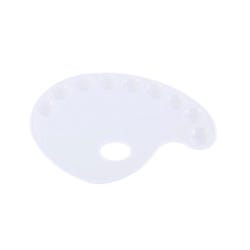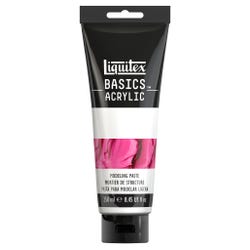Textural Techniques

Description
Lesson Plan and Artwork by Phyllis M. Annett
Textural Techniques is a lesson designed for students to study and create a painting on canvas using various textural techniques appropriate for acrylic paint. Liquitex BASICS Acrylics are chosen for their heavy bodied, buttery consistency and brilliant pigmentation. The use of textural techniques, tools and additives will be explored and implemented to create various textured surfaces on the paintings.
Objectives
- Get inspired by works of various artists who used techniques to create texture and depth to their work.
- Formulate a good composition, incorporating the Elements and Principles of Art and Design.
- Discern various textural techniques from works of artists and implement the same in their own work.
Supplies Needed
Liquitex® BASICS® Acrylic Paint Set, Assorted Colors, Set of 14
Liquitex® BASICS® Value Long Handle White Nylon Brush Assortment, Set of 4
Liquitex® BASICS® Modeling Paste, 8.45 Ounces
Fredrix® Gallerywrap Stretched Canvas, 12 x 16 in
Colour Shapers® Flexible Durable Large Color Shapers, Set of 5
Jack Richeson™ Oval Plastic Palette, 8 x 11 in, 9 Wells
Jack Richeson™ Plastic Flexible Super Safety Painting Knife Set, Set of 5
Sax® Genuine Primed Canvas Pad, 18 x 24 in, White, 10 Sheets/Pad
Standards
Standard #2: Organize and develop artistic ideas and work.
Standard #3: Refine and complete artistic work.
Standard #5: Develop and refine artistic work for presentation.
Standard #7: Perceive and analyze artistic work.
Standard #11: Relate artistic ideas and works with societal, cultural and historical context to deepen understanding.
Instructions
1
Have students study the works of artists that have used textural techniques in their paintings. A review of the Elements and Principles of Design will inform students how they are the backbone of any art work.
2
Show students prints and computer images from the textured art of: Vincent Van Gogh, Claude Monet, Paul Cézanne, Paul Gauguin, Eugéne Delacroix, Arthur Maderson, J. M. W. Turner and Brian Bennett.
3
Inform students of the advantages of using acrylic paint: water clean up, versatility to work on many substrates such as canvas, wood, paper, fabric, boards and even metal and rubber.
4
Landscapes, of any kind, will be the subject for the work.
5
Demonstrate the following textural effects appropriate for acrylics; Underpainting, Impasto, Glazing, Layering, Palette Knife Painting, Feathering, Scumbling, Defining Edges and Staining.
6
Let students practice on pieces of scrap canvas or heavy matte board before starting on stretched canvas. Then, distribute drawing paper for students to work out a good composition for their paintings.
7
Demonstrate and direct students to do an underpainting and then blocking in of lights and darks with washes of acrylic color. Stress that ‘Underpainting’ is done to give the painting a dominant overall color that will knit the sections of the painting together. A review of ‘Color Theory” will help students to formulate color schemes.
8
Encourage students to create big broad areas of color and form to give their work movement and rhythm as well as perspective.
9
Take a session to formulate criteria for students to evaluate their work and that of others. This will help students to remember to incorporate texture, good color schemes and compositions in their work.
10
When all work is completed, display paintings and have an evaluation session.




